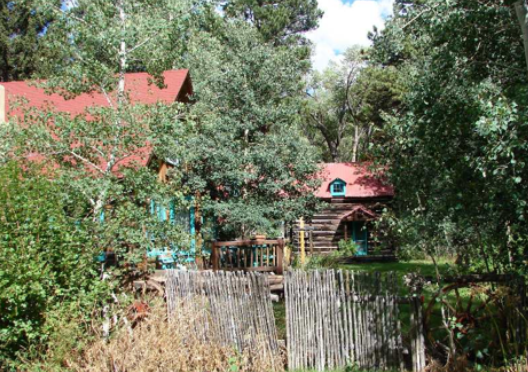Poudre Canyon Historical Tour
Written by Sue Abbot Schneider for the Poudre Canyon Riverbank
Reported and adapted by Pat Clemens for RFHS website.
Red Feather Historical Society toured the Poudre Canyon on August 20, 2014 with Sandra Case Lundt as our guide. The tour began at Red Gate Lodge where Fritz Venable showed us the original log cabin which was moved log by log from the Manhattan mining camp. She spoke of summers up the Canyon, jumping into the sawdust from the rafters in the ice house, climbing “look-out-rock”, and meals eaten at the “summer kitchen”.

The group was then told about the former site of the Rustic Resort. She spoke of the original Rustic Hotel which was constructed in 1881 on the north side of the road and built to service travelers on the Stewart toll road, which was the original route down Pingree Hill. Through the years it was bought and sold, lost to tax sales and renovated, but somehow it never seemed to prosper. It was finally demolished in 1978 after being condemned. A cafe, store, gas station and some cabins were built on the south side of the road. Through the years numerous owners tried to make a go of it, but the end finally came when the building burned to the ground in the early morning hours in 2008.
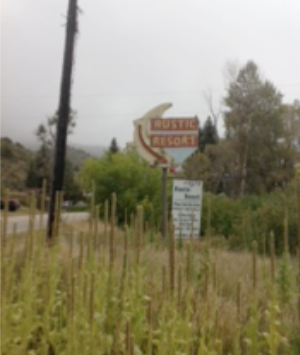
Next the group entered “Norman Fry country”, first at Abbott’s Pinehurst and then to Fry’s final residence on the Poudre, Fairkytes. Sue gave a brief history of Pinehurst. John Cooper originally homesteaded there in 1885, and built a log cabin and barn (still standing, barely). He sold the homestead to Reginal N. DeRivaz and Eustace Dixon, two English remittance men (younger sons of nobility with no inheritance) in 1887. Norman Fry, another younger son of English nobility, was sent to the two men to learn about ranching when he was 17. Turned out the two knew little about ranching (more about card playing and drinking whiskey), so Norman washed dishes, did chores and learned to fly fish. Being a resourceful young man he set about learning all he could from other
residents, and in 1899 he homesteaded above Pinehurst at Twin Pines.
Although we weren’t able to visit Twin Pines, Sue gave a description of the homestead. Sue then related how DeRivaz and Dixon lost the house and through a series of tax sales her great-great uncle A.W. Scott acquired the property in 1895. Scott was a druggist and prosperous businessman in Ft. Collins, and he and his wife “Auntie Scott” hosted many a notable Ft. Collins pioneer at Pinehurst during the summers. Sue’s grandfather Earl Abbott and father Scott Abbott inherited it from the childless Scott’s in the 30s and it now belongs to Scott’s children. Sue then opened Pinehurst, the original ice house and barn to the visitors who were able to wander through and see original guest books from the early days (1918-1930s), Auntie Scott’s side saddle and various artifacts from 120 years of family ownership.
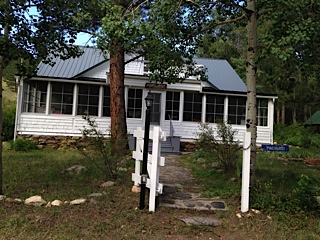
Next we traveled down the road to Fairkytes, Norman Fry’s final home in the Canyon. He and his wife Maude built the house and Maude’s artistic touch can be seen throughout.
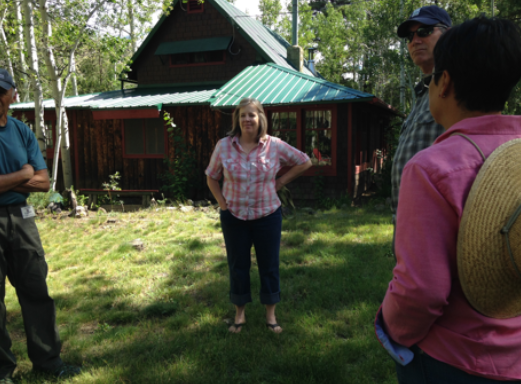
Peggy Parrott, who with her husband Phil are part of the trust that owns Fairkytes, graciously led us to the shrine, the final resting place for Maude, Norman, their children and grand-children and a lovely spot for reflection.
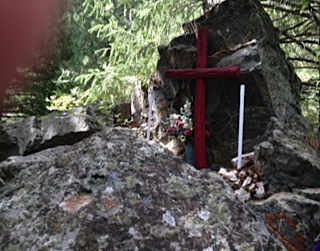
She then welcomed us into the home which has been well preserved through the years and certainly takes one back to the early years of Canyon society. We were also able to visit “Duck-In”, a nearby guest cabin which has been the site of 45 honeymoons (including Phil and Peggy), only 2 of which ended in divorce!
Then we traveled to the fire station/community building where Fritz Venable opened the Eggers School Museum to the tour participants.
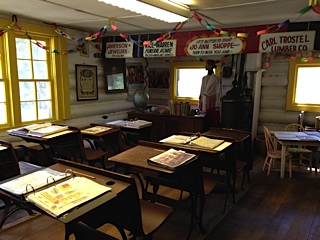
Sandra, Sheryl Case Hayes, Christy Case French and Cathy Revis spoke about attending the school and shared their memories of school in the one room schoolhouse. Sandra then took us to the Old Poudre City stamp mill and gave us a comprehensive history of John Zimmerman, John McNabb, and the formation of Old Poudre City. She told of us Zimmerman’s heroism when warning the residents of Old Poudre City that the Chambers Lake dam had broke in 1891, saving all of them but exhausting his horse to the point of death.

We traveled back to the chapel where she spoke of the amazing community which was able to construct the chapel and how it was truly a work of God. There were many examples of good deeds from residents and visitors alike and the resulting building is truly a testament to the community. We enjoyed our sack lunches in the community building and Sandra related more history about the Zimmerman’s Keystone Hotel, which sadly was demolished by the Game and Fish in 1946. She asked those present to close their eyes as she read some promotional literature describing the stage trip from Ft. Collins to the hotel and all that travelers would experience. The hotel was truly a showcase, with three stories, over 40 rooms, hot and cold water, a billiard room, a music room and ball room.
Sandra, Sheryl and Christy then related the history of Arrowhead Lodge and spoke about growing up helping their parents serve the famous Arrowhead Sunday chicken dinners, cleaning cabins, washing dishes and still having plenty of time for fun, including jeep and fishing trips, volleyball and movies. We drove up the road and toured the outside of Arrowhead, but couldn’t get inside since the Forest Service closes the visitor center on Labor Day.
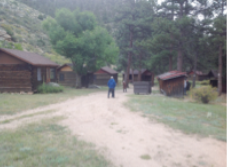
Then it was on to Iola Revis’s and the former site of the Zimmerman’s Keystone Hotel. Cathy took us across the bridge, where remnants of the original bridge are still visible, and showed us where the hotel sat. All that remains is an old stone building and an apple tree that was planted by the Zimmerman’s.
Finally we ended our tour at the Kinikinik Ranch, where David Bliss gave us a history of the place. The original owner, Charles Andrews, acquired all the homesteads along four miles of the Poudre in 1885. Andrews raised Shetland ponies, trained them to pull carriages, and sold them back east. He eventually sold a reduced acreage to Cap Williams in 1901, who was a formidable hunter and woman’s man. David shared a photo album of Cap’s many mountain lion kills, and showed us the “secret” doors from the guest rooms that allowed (allegedly!) his women visitors a quick exit or Cap the same. David’s grandparents bought the ranch at auction and after a disastrous year raising sheep, they moved to cattle. Clarence and Eunice Bliss were instrumental in the early years of the chapel. Clarence provided wonderful cello music and Eunice taught Sunday School for many years. David’s father Charles Bliss and his second wife Elyse added a modern addition to the original ranch house.
